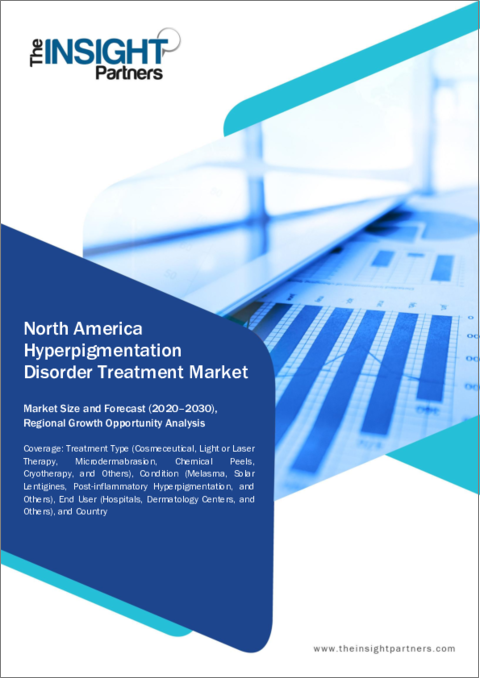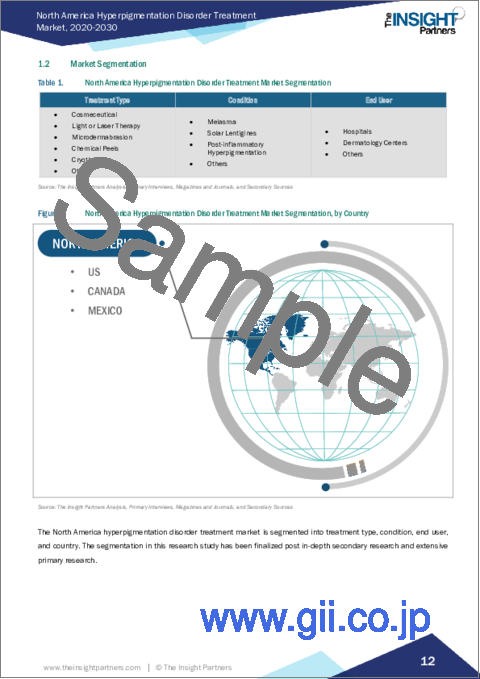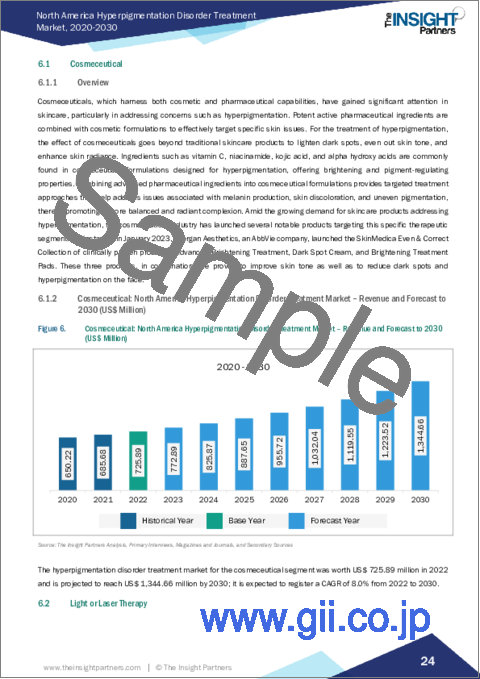|
|
市場調査レポート
商品コード
1597094
北米の色素沈着症治療市場:2030年までの予測 - 地域別分析 - 治療タイプ別、症状別、エンドユーザー別North America Hyperpigmentation Disorder Treatment Market Forecast to 2030 - Regional Analysis - by Treatment Type, Condition, and End User |
||||||
|
|||||||
| 北米の色素沈着症治療市場:2030年までの予測 - 地域別分析 - 治療タイプ別、症状別、エンドユーザー別 |
|
出版日: 2024年10月03日
発行: The Insight Partners
ページ情報: 英文 84 Pages
納期: 即納可能
|
全表示
- 概要
- 図表
- 目次
北米の色素沈着症治療市場は、2022年に16億9,483万米ドルとなり、2030年までには30億2,873万米ドルに達すると予測され、2022年から2030年までのCAGRは7.5%と推定されます。
肝斑の有病率の上昇が北米の色素沈着症治療市場を牽引
最も支配的な色素沈着疾患の一つである肝斑は、顔面、特に顎、上唇、鼻、額、頬に、境界のある左右対称の淡色から暗褐色の斑点が特徴です。女性および色黒の人に多いです。肝斑では、口唇、下顎および顔面中央部の臨床的特徴が一般的です。日光暴露、ホルモンの変動、妊娠、遺伝的要因、化粧品、医薬品はすべて肝斑の発生に関連しています。さまざまな研究から、一般人口における肝斑の全有病率は1%から50%と推定されています。肝斑症例の55%から64%が、同じ症状の家族歴を報告しています。さらに、東アジア系およびヒスパニック系の人々、ならびにフィッツパトリック皮膚のフォトタイプが高い患者(IV~VI)において、より高い有病率が報告されています。
妊娠も肝斑の一般的な原因です。この症状は、経口避妊薬やホルモン剤を服用している女性にも影響します。エストロゲン、プロゲステロン、メラノサイト刺激ホルモンの濃度は、通常妊娠中期に上昇するため、その影響も考えられます。2023年8月の米国立生物工学情報センター(NCBI)によると、肝斑は生殖期に多く、思春期前に発症することはまれです。この症状は妊婦の15%から50%にみられ、その有病率は地域によって1.5%から33%です。そのため、肝斑の有病率の増加が色素沈着症治療に対する需要の引き金となっています。
北米の色素沈着症治療市場概要
北米の色素沈着症治療市場は、米国、カナダ、メキシコに区分されます。2023年の北米の色素沈着症治療市場シェアは米国が最大です。Skin of Color Update 2024(皮膚科学会)によると、米国の人口動態は、ヒスパニック系、アジア系、アフリカ系の国際移住による民族・人種的多様性の拡大とともに進化しており、2050年頃にはフィッツパトリックIII、IV、V、VI肌タイプのマイノリティが主流になる可能性が高いです。特に、ヒスパニック系人口は米国で最も急成長している人口集団のひとつであり、2014年の5,500万人から2060年には1億1,900万人に増加すると推定されています。色黒の肌タイプは色素沈着障害を起こしやすいです。
米国における美容整形手術の件数は、過去10年間で大幅に増加しています。国際形成外科学会(ISAPS)によると、2021年の非外科的美容施術件数は、世界全体で2020年と比較して19.9%増加しました。インテンス・パルス・ライト(IPL)治療は、低侵襲性美容施術のトップ5に入っており、米国では2020年に約82万7,000件のIPL施術が行われました。このように、非侵襲的処置の技術的進歩は、米国の色素沈着症治療市場にさらなる利益をもたらす可能性が高いです。2023年3月、米国食品医薬品局(FDA)はCandela CorporationのPicoWayレーザーをカフェオレ斑、肝斑、黒子、太田母斑の治療に認可しました。以前、このレーザーシステムは、良性色素性病変、ニキビ跡、しわ、タトゥー除去などの治療で承認されていました。
したがって、民族や人種の多様性の増大、コスメシューティク、ケミカルピーリング、凍結療法、光、レーザー治療などの非侵襲的医療美容施術の市場開拓などの要因が、米国における色素沈着症治療市場の成長に寄与しています。
北米の色素沈着症治療市場の収益と2030年までの予測(金額)
北米の色素沈着症治療市場セグメンテーション
北米の色素沈着症治療市場は、治療タイプ、症状、エンドユーザー、国に分類されます。
治療タイプ別では、北米の色素沈着症治療市場は、コスメシューティカル、光・レーザー治療、マイクロダーマブレーション、ケミカルピーリング、凍結療法、その他に区分されます。2022年には、コスメシューティカルセグメントが最大の市場シェアを占めました。
症状別に見ると、北米の色素沈着症治療市場は、肝斑、日光黒子、炎症後色素沈着、その他に区分されます。肝斑セグメントは2022年に最大の市場シェアを占めました。
エンドユーザー別では、北米の色素沈着症治療市場は病院、皮膚科センター、その他に区分されます。病院セグメントが2022年に最大の市場シェアを占めました。
国別では、北米の色素沈着症治療市場は米国、カナダ、メキシコに区分されます。米国が2022年の北米の色素沈着症治療市場シェアを独占しました。
AbbVie Inc、Bayer AG、Galderma SA、L'OREAL S.A.、Lutronic Co Ltd、Obagi Cosmeceuticals LLC、Vivier Pharma Incは、北米の色素沈着症治療市場で事業を展開する主要企業です。
目次
第1章 イントロダクション
第2章 エグゼクティブサマリー
- 主要な洞察
第3章 調査手法
- 調査範囲
- 2次調査
- 1次調査
第4章 北米の色素沈着症治療市場:主要市場ダイナミクス
- 市場促進要因
- 肝斑の有病率の上昇
- 色素沈着症啓発プログラムの増加
- 市場抑制要因
- 治療費の高騰
- 市場機会
- 戦略的取り組み:市場企業別
- 今後の動向
- 切除レーザーの使用
- PATH-3技術に基づく新製品
- 促進要因と抑制要因の影響
第5章 色素沈着症治療市場:北米分析
- 北米の色素沈着症治療市場収益、2020年~2030年
第6章 北米の色素沈着症治療市場分析:治療タイプ別
- コスメシューティカル
- 光またはレーザー療法
- マイクロダーマブレーション
- ケミカルピーリング
- 凍結療法
- その他
第7章 北米の色素沈着症治療市場分析:症状別
- 肝斑
- 日光黒子
- 炎症後色素沈着
- その他
第8章 北米の色素沈着症治療市場分析:エンドユーザー別
- 病院
- 皮膚科センター
- その他
第9章 北米の色素沈着症治療市場:国別分析
- 米国
- カナダ
- メキシコ
第10章 色素沈着症治療市場:業界情勢
- 色素沈着症治療市場の成長戦略
- 有機的成長戦略
- 無機的成長戦略
第11章 企業プロファイル
- AbbVie Inc
- Galderma SA
- Obagi Cosmeceuticals LLC
- Bayer AG
- Lutronic Co Ltd
- L'OREAL S.A.
- Pierre Fabre SA
- Vivier Pharma Inc
第12章 付録
List Of Tables
- Table 1. North America Hyperpigmentation Disorder Treatment Market Segmentation
- Table 2. North America Hyperpigmentation Disorder Treatment Market - Revenue and Forecast to 2030 (US$ Million) - by Treatment Type
- Table 3. North America Hyperpigmentation Disorder Treatment Market - Revenue and Forecast to 2030 (US$ Million) - by Condition
- Table 4. North America Hyperpigmentation Disorder Treatment Market - Revenue and Forecast to 2030 (US$ Million) - by End User
- Table 5. North America Hyperpigmentation Disorder Treatment Market - Revenue and Forecast to 2030 (US$ Million) - by Country
- Table 6. Number of Laser-Based Nonsurgical Procedures Performed, 2020
- Table 7. US: Hyperpigmentation Disorder Treatment Market - Revenue and Forecast to 2030 (US$ Million) - by Treatment Type
- Table 8. US: Hyperpigmentation Disorder Treatment Market - Revenue and Forecast to 2030 (US$ Million) - by Condition
- Table 9. US: Hyperpigmentation Disorder Treatment Market - Revenue and Forecast to 2030 (US$ Million) - by End User
- Table 10. Canada: Hyperpigmentation Disorder Treatment Market - Revenue and Forecast to 2030 (US$ Million) - by Treatment Type
- Table 11. Canada: Hyperpigmentation Disorder Treatment Market - Revenue and Forecast to 2030 (US$ Million) - by Condition
- Table 12. Canada: Hyperpigmentation Disorder Treatment Market - Revenue and Forecast to 2030 (US$ Million) - by End User
- Table 13. Mexico: Hyperpigmentation Disorder Treatment Market - Revenue and Forecast to 2030 (US$ Million) - by Treatment Type
- Table 14. Mexico: Hyperpigmentation Disorder Treatment Market - Revenue and Forecast to 2030 (US$ Million) - by Condition
- Table 15. Mexico: Hyperpigmentation Disorder Treatment Market - Revenue and Forecast to 2030 (US$ Million) - by End User
- Table 16. Recent Organic Growth Strategies in Hyperpigmentation Disorder Treatment Market
- Table 17. Recent Inorganic Growth Strategies in the Hyperpigmentation Disorder Treatment Market
- Table 18. Glossary of Terms, Hyperpigmentation Disorder Treatment Market
List Of Figures
- Figure 1. North America Hyperpigmentation Disorder Treatment Market Segmentation, by Country
- Figure 2. North America Hyperpigmentation Disorder Treatment Market - Key Market Dynamics
- Figure 3. Impact Analysis of Drivers and Restraints
- Figure 4. North America Hyperpigmentation Disorder Treatment Market Revenue (US$ Million), 2022-2030
- Figure 5. North America Hyperpigmentation Disorder Treatment Market Share (%) - by Treatment Type (2022 and 2030)
- Figure 6. Cosmeceutical: North America Hyperpigmentation Disorder Treatment Market - Revenue and Forecast to 2030 (US$ Million)
- Figure 7. Light or Laser Therapy: North America Hyperpigmentation Disorder Treatment Market - Revenue and Forecast to 2030 (US$ Million)
- Figure 8. Microdermabrasion: North America Hyperpigmentation Disorder Treatment Market - Revenue and Forecast to 2030 (US$ Million)
- Figure 9. Chemical Peels: North America Hyperpigmentation Disorder Treatment Market - Revenue and Forecast to 2030 (US$ Million)
- Figure 10. Cryotherapy: North America Hyperpigmentation Disorder Treatment Market - Revenue and Forecast to 2030 (US$ Million)
- Figure 11. Others: North America Hyperpigmentation Disorder Treatment Market - Revenue and Forecast to 2030 (US$ Million)
- Figure 12. North America Hyperpigmentation Disorder Treatment Market Share (%) - by Condition (2022 and 2030)
- Figure 13. Melasma: North America Hyperpigmentation Disorder Treatment Market - Revenue and Forecast to 2030 (US$ Million)
- Figure 14. Solar Lentigines: North America Hyperpigmentation Disorder Treatment Market - Revenue and Forecast to 2030 (US$ Million)
- Figure 15. Post-inflammatory Hyperpigmentation: North America Hyperpigmentation Disorder Treatment Market - Revenue and Forecast to 2030 (US$ Million)
- Figure 16. Others: North America Hyperpigmentation Disorder Treatment Market - Revenue and Forecast to 2030 (US$ Million)
- Figure 17. North America Hyperpigmentation Disorder Treatment Market Share (%) - by End User (2022 and 2030)
- Figure 18. Hospitals: North America Hyperpigmentation Disorder Treatment Market - Revenue and Forecast to 2030 (US$ Million)
- Figure 19. Dermatology Centers: North America Hyperpigmentation Disorder Treatment Market - Revenue and Forecast to 2030 (US$ Million)
- Figure 20. Others: North America Hyperpigmentation Disorder Treatment Market - Revenue and Forecast to 2030 (US$ Million)
- Figure 21. North America Hyperpigmentation Disorder Treatment Market, By Key Country - Revenue (2022) (US$ Million)
- Figure 22. North America Hyperpigmentation Disorder Treatment Market Breakdown, by Key Countries, 2022 and 2030 (%)
- Figure 23. US: Hyperpigmentation Disorder Treatment Market - Revenue and Forecast to 2030 (US$ Million)
- Figure 24. Canada: Hyperpigmentation Disorder Treatment Market - Revenue and Forecast to 2030 (US$ Million)
- Figure 25. Mexico: Hyperpigmentation Disorder Treatment Market - Revenue and Forecast to 2030 (US$ Million)
- Figure 26. Growth Strategies in Hyperpigmentation Disorder Treatment Market
The North America hyperpigmentation disorder treatment market was valued at US$ 1,694.83 million in 2022 and is expected to reach US$ 3,028.73 million by 2030; it is estimated to register a CAGR of 7.5% from 2022 to 2030 .
Rise in Prevalence of Melasma Fuels North America Hyperpigmentation Disorder Treatment Market
Melasma, one of the most dominant hyperpigmentation conditions, is characterized by symmetrical light to dark muddy-brown macules with borders on the face, particularly the chin, upper lip, nose, forehead, and cheeks. It is prevalent among women and those with darker complexion. Malar, mandibular, and centrofacial clinical features are common in melasma. Sun exposure, hormonal variations, pregnancy, hereditary factors, cosmetics, and medicines have all been linked to the development of melasma. Various studies have estimated that the overall prevalence of melasma in the general population ranges from 1% to 50%. 55-64% of melasma cases have reported a family history of the same condition. Moreover, a greater prevalence is reported in individuals of East Asian and Hispanic origins as well as in patients with high Fitzpatrick skin phototypes (IV to VI); it is also higher in individuals living in locations that receive intense UV radiation.
Pregnancy is another common cause of melasma. This condition also impacts women taking oral contraceptives and hormones. Estrogen, progesterone, and melanocyte-stimulating hormone levels normally rise during the third trimester of pregnancy, which may be a factor. According to the National Center for Biotechnology Information (NCBI) in August 2023, melasma is more common in reproductive years, and it rarely occurs before puberty; the condition occurs in 15-50% of pregnant women, and its prevalence ranges from 1.5% to 33%, depending on the population in a different region. Therefore, an upsurge in melasma prevalence triggers the demand for hyperpigmentation treatments.
North America Hyperpigmentation Disorder Treatment Market Overview
The hyperpigmentation disorder treatment market in North America is segmented into the US, Canada, and Mexico. The US held the largest North America hyperpigmentation disorder treatment market share in 2023. According to the Skin of Color Update 2024 (a dermatology conference), the demographics of the US are evolving with the growth of ethnic and racial diversity driven by international migration of Hispanics, Asian populations, and Africans in the country, which is also likely to lead to a minority-majority shift around the year 2050 toward individuals of Fitzpatrick III, IV, V, and VI skin types. Specifically, the Hispanic population is expected to be among the fastest-growing demographic groups in the US, with estimated growth from 55 million in 2014 to 119 million in 2060. A dark skin type is more prone to hyperpigmentation disorders.
The number of aesthetic procedures in the US has increased significantly over the last 10 years. According to the International Society of Plastic Surgeons (ISAPS), the number of nonsurgical aesthetic procedures rose by 19.9% in 2021 compared to 2020 globally. Intense pulsed light (IPL) treatment is among the top 5 minimally invasive cosmetic procedures, and ~827,000 IPL procedures were performed in the US in 2020. Thus, technological advancements in noninvasive procedures are likely to further benefit the hyperpigmentation disorder treatment market in the US. In March 2023, the US Food and Drug Administration (FDA) cleared Candela Corporation's PicoWay laser to treat cafe au lait, melasma, lentigines, and Nevus of Ota. Previously, the laser system was approved for the treatment of benign pigmented lesions, acne scarring, wrinkles, and tattoo removal, among other indications.
Therefore, factors such as the growing ethnic and racial diversity, and the development of noninvasive medical aesthetic procedures such as cosmeceutics, chemical peels, cryotherapy, light, or laser therapy contribute to the hyperpigmentation disorder treatment market growth in the US.
North America Hyperpigmentation Disorder Treatment Market Revenue and Forecast to 2030 (US$ Million)
North America Hyperpigmentation Disorder Treatment Market Segmentation
The North America hyperpigmentation disorder treatment market is categorized into treatment type, condition, end user, and country.
Based on treatment type, the North America hyperpigmentation disorder treatment market is segmented into cosmeceutical, light or laser therapy, microdermabrasion, chemical peels, cryotherapy, and others. The cosmeceutical segment held the largest market share in 2022.
Based on condition, the North America hyperpigmentation disorder treatment market is segmented into melasma, solar lentigines, post-inflammatory hyperpigmentation, and others. The melasma segment held the largest market share in 2022.
Based on end user, the North America hyperpigmentation disorder treatment market is segmented into hospitals, dermatology centers, and others. The hospitals segment held the largest market share in 2022.
By country, the North America hyperpigmentation disorder treatment market is segmented into the US, Canada, and Mexico. The US dominated the North America hyperpigmentation disorder treatment market share in 2022.
AbbVie Inc, Bayer AG, Galderma SA, L'OREAL S.A., Lutronic Co Ltd, Obagi Cosmeceuticals LLC, and Vivier Pharma Inc are some of the leading companies operating in the North America hyperpigmentation disorder treatment market.
Table Of Contents
1. Introduction
- 1.1 The Insight Partners Research Report Guidance
- 1.2 Market Segmentation
2. Executive Summary
- 2.1 Key Insights
3. Research Methodology
- 3.1 Coverage
- 3.2 Secondary Research
- 3.3 Primary Research
4. North America Hyperpigmentation Disorder Treatment Market - Key Market Dynamics
- 4.1 Market Drivers
- 4.1.1 Rise in Prevalence of Melasma
- 4.1.2 Increasing Number of Hyperpigmentation Disorder Awareness Programs
- 4.2 Market Restraints
- 4.2.1 High Cost of Treatments
- 4.3 Market Opportunities
- 4.3.1 Strategic Initiatives by Market Players
- 4.4 Future Trends
- 4.4.1 Use of Ablative Lasers
- 4.4.2 Novel Products Based on PATH-3 Technology
- 4.5 Impact of Drivers and Restraints:
5. Hyperpigmentation Disorder Treatment Market - North America Analysis
- 5.1 North America Hyperpigmentation Disorder Treatment Market Revenue (US$ Million), 2020-2030
6. North America Hyperpigmentation Disorder Treatment Market Analysis - by Treatment Type
- 6.1 Cosmeceutical
- 6.1.1 Overview
- 6.1.2 Cosmeceutical: North America Hyperpigmentation Disorder Treatment Market - Revenue and Forecast to 2030 (US$ Million)
- 6.2 Light or Laser Therapy
- 6.2.1 Overview
- 6.2.2 Light or Laser Therapy: North America Hyperpigmentation Disorder Treatment Market - Revenue and Forecast to 2030 (US$ Million)
- 6.3 Microdermabrasion
- 6.3.1 Overview
- 6.3.2 Microdermabrasion: North America Hyperpigmentation Disorder Treatment Market - Revenue and Forecast to 2030 (US$ Million)
- 6.4 Chemical Peels
- 6.4.1 Overview
- 6.4.2 Chemical Peels: North America Hyperpigmentation Disorder Treatment Market - Revenue and Forecast to 2030 (US$ Million)
- 6.5 Cryotherapy
- 6.5.1 Overview
- 6.5.2 Cryotherapy: North America Hyperpigmentation Disorder Treatment Market - Revenue and Forecast to 2030 (US$ Million)
- 6.6 Others
- 6.6.1 Overview
- 6.6.2 Others: North America Hyperpigmentation Disorder Treatment Market - Revenue and Forecast to 2030 (US$ Million)
7. North America Hyperpigmentation Disorder Treatment Market Analysis - by Condition
- 7.1 Melasma
- 7.1.1 Overview
- 7.1.2 Melasma: North America Hyperpigmentation Disorder Treatment Market - Revenue and Forecast to 2030 (US$ Million)
- 7.2 Solar Lentigines
- 7.2.1 Overview
- 7.2.2 Solar Lentigines: North America Hyperpigmentation Disorder Treatment Market - Revenue and Forecast to 2030 (US$ Million)
- 7.3 Post-inflammatory Hyperpigmentation
- 7.3.1 Overview
- 7.3.2 Post-inflammatory Hyperpigmentation: North America Hyperpigmentation Disorder Treatment Market - Revenue and Forecast to 2030 (US$ Million)
- 7.4 Others
- 7.4.1 Overview
- 7.4.2 Others: North America Hyperpigmentation Disorder Treatment Market - Revenue and Forecast to 2030 (US$ Million)
8. North America Hyperpigmentation Disorder Treatment Market Analysis - by End User
- 8.1 Hospitals
- 8.1.1 Overview
- 8.1.2 Hospitals: North America Hyperpigmentation Disorder Treatment Market - Revenue and Forecast to 2030 (US$ Million)
- 8.2 Dermatology Centers
- 8.2.1 Overview
- 8.2.2 Dermatology Centers: North America Hyperpigmentation Disorder Treatment Market - Revenue and Forecast to 2030 (US$ Million)
- 8.3 Others
- 8.3.1 Overview
- 8.3.2 Others: North America Hyperpigmentation Disorder Treatment Market - Revenue and Forecast to 2030 (US$ Million)
9. North America Hyperpigmentation Disorder Treatment Market - Country Analysis
- 9.1 North America Hyperpigmentation Disorder Treatment Market
- 9.1.1 North America Hyperpigmentation Disorder Treatment Market - Revenue and Forecast Analysis - by Country
- 9.1.1.1 North America Hyperpigmentation Disorder Treatment Market - Revenue and Forecast Analysis - by Country
- 9.1.1.2 US
- 9.1.1.3 US: Hyperpigmentation Disorder Treatment Market - Revenue and Forecast to 2030 (US$ Million)
- 9.1.1.3.1 US: Hyperpigmentation Disorder Treatment Market Breakdown, by Treatment Type
- 9.1.1.3.2 US: Hyperpigmentation Disorder Treatment Market Breakdown, by Condition
- 9.1.1.3.3 US: Hyperpigmentation Disorder Treatment Market Breakdown, by End User
- 9.1.1.4 Canada
- 9.1.1.5 Canada: Hyperpigmentation Disorder Treatment Market - Revenue and Forecast to 2030 (US$ Million)
- 9.1.1.5.1 Canada: Hyperpigmentation Disorder Treatment Market Breakdown, by Treatment Type
- 9.1.1.5.2 Canada: Hyperpigmentation Disorder Treatment Market Breakdown, by Condition
- 9.1.1.5.3 Canada: Hyperpigmentation Disorder Treatment Market Breakdown, by End User
- 9.1.1.6 Mexico
- 9.1.1.7 Mexico: Hyperpigmentation Disorder Treatment Market - Revenue and Forecast to 2030 (US$ Million)
- 9.1.1.7.1 Mexico: Hyperpigmentation Disorder Treatment Market Breakdown, by Treatment Type
- 9.1.1.7.2 Mexico: Hyperpigmentation Disorder Treatment Market Breakdown, by Condition
- 9.1.1.7.3 Mexico: Hyperpigmentation Disorder Treatment Market Breakdown, by End User
- 9.1.1 North America Hyperpigmentation Disorder Treatment Market - Revenue and Forecast Analysis - by Country
10. Hyperpigmentation Disorder Treatment Market - Industry Landscape
- 10.1 Overview
- 10.2 Growth Strategies in Hyperpigmentation Disorder Treatment Market
- 10.3 Organic Growth Strategies
- 10.3.1 Overview
- 10.4 Inorganic Growth Strategies
- 10.4.1 Overview
11. Company Profiles
- 11.1 AbbVie Inc
- 11.1.1 Key Facts
- 11.1.2 Business Description
- 11.1.3 Products and Services
- 11.1.4 Financial Overview
- 11.1.5 SWOT Analysis
- 11.1.6 Key Developments
- 11.2 Galderma SA
- 11.2.1 Key Facts
- 11.2.2 Business Description
- 11.2.3 Products and Services
- 11.2.4 Financial Overview
- 11.2.5 SWOT Analysis
- 11.2.6 Key Developments
- 11.3 Obagi Cosmeceuticals LLC
- 11.3.1 Key Facts
- 11.3.2 Business Description
- 11.3.3 Products and Services
- 11.3.4 Financial Overview
- 11.3.5 SWOT Analysis
- 11.3.6 Key Developments
- 11.4 Bayer AG
- 11.4.1 Key Facts
- 11.4.2 Business Description
- 11.4.3 Products and Services
- 11.4.4 Financial Overview
- 11.4.5 SWOT Analysis
- 11.4.6 Key Developments
- 11.5 Lutronic Co Ltd
- 11.5.1 Key Facts
- 11.5.2 Business Description
- 11.5.3 Products and Services
- 11.5.4 Financial Overview
- 11.5.5 SWOT Analysis
- 11.5.6 Key Developments
- 11.6 L'OREAL S.A.
- 11.6.1 Key Facts
- 11.6.2 Business Description
- 11.6.3 Products and Services
- 11.6.4 Financial Overview
- 11.6.5 SWOT Analysis
- 11.6.6 Key Developments
- 11.7 Pierre Fabre SA
- 11.7.1 Key Facts
- 11.7.2 Business Description
- 11.7.3 Products and Services
- 11.7.4 Financial Overview
- 11.7.5 SWOT Analysis
- 11.7.6 Key Developments
- 11.8 Vivier Pharma Inc
- 11.8.1 Key Facts
- 11.8.2 Business Description
- 11.8.3 Products and Services
- 11.8.4 Financial Overview
- 11.8.5 SWOT Analysis
- 11.8.6 Key Developments
12. Appendix
- 12.1 About The Insight Partners
- 12.2 Glossary of Terms






